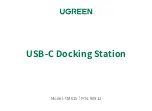
6
EN
TRANSMITTER BOX-BATTERY INSTALLATION
The solar panel on transmitter box is an energy saving feature, which is an
environmentally friendly way to provide power to the sensors and prolongs battery
life. It can entirely provide power to the supplied rechargeable battery. Sensors
can operate entirely on the rechargeable battery power. Locate the transmitter box
under direct sunlight for power supplying by the solar panel.
The rechargeable battery from factory is not with full
battery for long time use and it probably becomes
low battery during the shipping. We recommend
you to charge it for several hours by the connected
solar panel.
You can also purchase a power adapter separately
for directly providing power to the transmitter box.
The output voltage of the power adapter is 3V.
Route the adapter cable through the cable slot.
Please check the solar panel connection. If it
is not firmly plugged, please re-connect the
solar panel:
Plug the end of color-corded connector into corresponding socket in the transmitter
box as shown below and place the wires neatly inside the box.
To install the rechargeable battery:
Insert the battery into the battery compartment, matching the polarity
+/-
.
CHANNEL SETTING
Your weather station system can expand with up to 8
sets of thermometer & humidity sensors, and one of
each of wind and rain sensors, which share one main
unit to display the weather readings. You can number
each transmitter box with an independent channel ID
(
1
-
8
) by sliding the switches.
Please follow the below chart to adjust the sliding switches of SW1:
The below
0
in the chart represents
off
and
1
represents
on
.
CH
PIN 2
PIN 3
PIN 4
Channel 1
0
0
0
Channel 2
0
0
1
Channel 3
0
1
0
Channel 4
0
1
1
Channel 5
1
0
0
Channel 6
1
0
1
Channel 7
1
1
0
Channel 8
1
1
1
For obviously indicate the status of your channel, you can turn on the LED light in
the corresponding transmitter box by sliding the
PIN 1
switch to
1
.
Function
PIN 1
Disable LED
0
Enable LED
1
After setting, please turn off the LED light by sliding the
PIN 1
switch to
0
to save
power, and then close the box by tightening the screws.
The flashing LED indicates a normal transmission (See
LED Light Indicator
).
REMOVE SETTING
For removing the previous setting from the transmitter box, you can press
RESET
and
KEY
at a time, then only release
RESET
, red light flashes 5 times. Then
release
KEY
. The channel setting and calibrated wind direction are all removed
from the transmitter box.
LED LIGHT INDICATOR
There are three colors of LED lights in transmitter box, green, red and blue.
Different color combinations indicate different status.
Light Color
Operations
Blue->green->red
Flash once when you (Press and )release
RESET
Red flashes every second
Flash 5 times then remove setting of all the
sensors from transmitter box (See
Remove
setting
section)
Red
Wind direction calibration
(See
Direction Calibration
).
Blue flashes
A normal transmission (WMR300A)
Green flashes
A normal transmission (WMR300)
SENSORS INSTALLATION
You have three options to install the sensors.
The transmitter box is capable of transmitting data wirelessly an approximate
operating range of 300m (1000 feet). Ideal placements for the sensor would be
in any location on the roof of a building that is in an open area away from trees
or other obstructions preventing from the wind flow for an accurate reading.
Additionally, locate the transmitter box at the direct sunlight for power supplying
by the solar panel.
Solar panel facing:
If you reside in the:
North
Southern Hemisphere
South
Northern Hemisphere
Make sure the temperature and humidity sensor should be located at least
1.5 meters above the ground surface to avoid the ground temperature affecting
accuracy of the temperature and humidity sensor.
Option 1: All sensors are installed on a pole.
Please take off the rain collector before installation and choose a pole with
the diameter that is about 32-45mm.
1. Locate one U-bolt without flat washers, lock washers and hex nuts into the gap
of the rain gauge (Figure 1).
2. Let the pole fully approach to the inner of the U-bolt (Figure 2).
3. Locate the other U-bolt without flat washers, lock washers and hex nuts into
the screw holes of the rain gauge (Figure 3).
4. Put the backing metal plate through the U-bolt and securely tighten two pairs of
the flat washers, lock washers and hex nuts over the plate (Figure 4) by wrench.
5. Insert the two ends of the first U-bolt into the screw holes of the wind sensor (Figure 5).
6. Tighten the other two pairs of flat washers, lock washers and hex nuts on the
U-bolt of the wind sensor by wrench (Figure 6).
Make sure the water bubble in the balance indicator on the rain gauge
stay within the circle. Check the balance status regularly for an accurate rainfall
rate reading.

























